More Flood Evidences Come to Light
From time to time, new research results give additional insight into the Biblical flood. In fact, for one who understands the Biblical flood, many current discoveries are easy to understand. For example, a recent article in Science “calls for critical reappraisal of all mudstones previously interpreted as having been continuously deposited under still waters”. 1 Because mud sediments are “the dominant sediment type on earth”, this reappraisal has tremendous implications for our understanding of the entire geological column.



